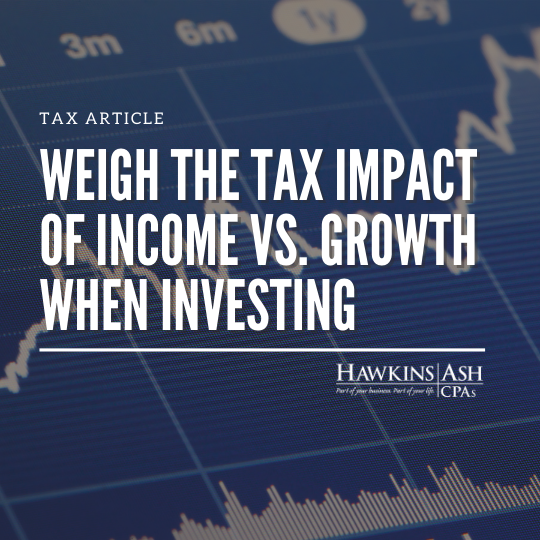As the 2018 tax-filing season heats up, investors have much to consider. Whether you structured your portfolio to emphasize income over growth — or vice versa, or perhaps a balance of the two — will have a substantial impact on your tax liability. Let’s take a look at a couple of the most significant “big picture” issues that affect income vs. growth.
Differing Dividends
One benefit of dividends is that they may qualify for preferential long-term capital gains tax rates. For the 2018 tax year, the top rate is 20% for high-income taxpayers (income of $425,800 or more). For those with incomes between $38,601 and $425,800, the rate is 15%. Individuals with incomes of $38,600 and below pay 0% on long-term capital gains.
Keep in mind, however, that only “qualified dividends” are eligible for these rates. Nonqualified dividends are taxed as ordinary income at rates as high as 37% for 2018. Qualified dividends must meet two requirements. First, the dividends must be paid by a U.S. corporation or a qualified foreign corporation. Second, the stock must be held for at least 61 days during the 121-day period that starts 60 days before the ex-dividend date and ends 60 days after that date.
A qualified foreign corporation is one that’s organized in a U.S. possession or in a country that has a current tax treaty with the United States, or whose stock is readily tradable on an established U.S. market. The ex-dividend date is the cutoff date for declared dividends. Investors who purchase stock on or after that date won’t receive a dividend payment.
Timing is Everything
One disadvantage of dividend-paying stocks (or mutual funds that invest in dividend-paying stocks) is that they accelerate taxes. Regardless of how long you hold the stock, you’ll owe taxes on dividends as they’re paid, which erodes your returns over time.
When you invest in growth stocks (or mutual funds that invest in growth stocks), you generally have greater control over the timing of the tax bite. These companies tend to reinvest their profits in the companies rather than pay them out as dividends, so taxes on the appreciation in value are deferred until you sell the stock.
Keeping an Eye Out
Regardless of your investment approach, you need to understand the tax implications of various investments so you can make informed decisions. You should also keep an eye on Congress. As of this writing, further tax law reform beyond the Tax Cuts and Jobs Act of 2017 isn’t on the horizon — but it’s being discussed. Contact our firm for the latest news and to discuss your tax and investment strategies.





